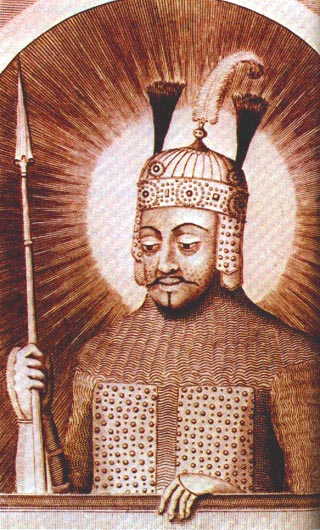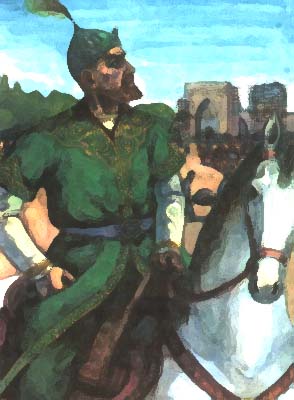The history of Samarkand during Tamerlane's campaigning
years ( 1372-1402) is a reflection of the history of the world. He rampaged
to Delhi and Baghdad and to the gates of Moscow and Constantinople, sending
back to Samarkand Asia's finest craftsmen and most precious treasures.
He named its districts after far-flung cities, and fearful emissaries sought
him there from Belling, Madrid and most points in between.
Like Alexander the Great and Genghls Khan he wanted to
rule the world. 'As there is  one
God in Heaven there must be one king on earth,' he explained early in his
career. 'The entire world is not worth more than one king.' But his fighting
was also driven by eco nomics: trade along the classic Silk Route through
Samarkand, Merv and northern Persia had fallen sharply since Genghis Khan's
destruction of its oases. Urgench, to the north, was now thriving at Samarkand's
expense, and was Tamerlane's first victim. Later, In his longest campaign
(1391-95), he conquered the lands with which Urgench had traded, those
of the Golden Horde on the Volga and in southern Russia. His aim was always
to bring trade back to Samarkand, which was now not just an entrepot but
a famed manufacturer of velvet and paper. one
God in Heaven there must be one king on earth,' he explained early in his
career. 'The entire world is not worth more than one king.' But his fighting
was also driven by eco nomics: trade along the classic Silk Route through
Samarkand, Merv and northern Persia had fallen sharply since Genghis Khan's
destruction of its oases. Urgench, to the north, was now thriving at Samarkand's
expense, and was Tamerlane's first victim. Later, In his longest campaign
(1391-95), he conquered the lands with which Urgench had traded, those
of the Golden Horde on the Volga and in southern Russia. His aim was always
to bring trade back to Samarkand, which was now not just an entrepot but
a famed manufacturer of velvet and paper.
The best description of Samarkand before the Russian
conquest is by Ruy Gonzalez de Clavijo, ambassador extraordinary from the
court of Henry Ill of Castile. In 1403 he began an epic journey from Spain
to Samarkand in the wake of Tamerlane's victorious army, which by capturing
Ankara had given Western Europe a breathing space from Ottoman expansionism.
But Europe was still more alarmed by Tamerlane himself. Henry wanted a
treaty.
Glavijo did not get him one, but he got a fluke glimpse
of Samarkand and its builder in their finest hour. Throughout the envoy's
sojourn the emperor was to be found among his wives and subjects feasting
on wine, mutton, horse-flesh and fruit in a succession of palatial silk
tents. In one of them Clavijo saw 'a flat emerald, four palms long, on
a golden table. In front of this table there was a golden tree made to
resemble an oak, with the trunk as big as a man's leg. The fruit of this
tree consisted of rubies, emeralds, turquoises, sapphires and wonderfully
large pearls. On this tree there were many birds made of enamelled gold
of various colours...
'The city itself,' he continued, 'is rather larger than
Seville, but lying outside are great numbers of houses which form extensive
suburbs. The township is surrounded by orchards and vineyards and between
them pass streets with open squares. These are all densely populated and
all kinds of goods are on sale with bread-stuffs and meat. Among these
orchards outside Samarkand are found the most noble and beautiful houses
and here Timur has his many palaces and pleasure grounds...'
 It
was 1404. Two massive construction projects, the Bibi Khanym mosque and
Tamerlane's own mausoleum , Gur Emir, were in progress in the city centre.
On a whim he ordered the construction of a grand bazaar in 20 days-or else
his engineers would pay with their lives. A thousand men were imprisoned
in the citadel making arms and armour for his planned invasion of China. It
was 1404. Two massive construction projects, the Bibi Khanym mosque and
Tamerlane's own mausoleum , Gur Emir, were in progress in the city centre.
On a whim he ordered the construction of a grand bazaar in 20 days-or else
his engineers would pay with their lives. A thousand men were imprisoned
in the citadel making arms and armour for his planned invasion of China.
The following year, shortly after setting out, he died.
The empire quickly shrunk, but as it did, Samarkand enjoyed half a century
of peace and prosperity under Tamerlane's grandson Ulug Bek (r. 1407-491.To
him we owe the Ulug Bek madrasa and the remains of an observatory-the most
intriguing relic of medieval Samarkand.
Ulug Bek was murdered by his son In 1449 for perceived
heresy Tamerlane's great- great- great-grandson Babur was bounded out of
the city in 1512 by the Uzbek Turks, having taken possession of it at the
turn of the century aged 14. He was the last of the Timurid dynasty-and
the first of another, the Mughal, at Delhi.
[back]
|

